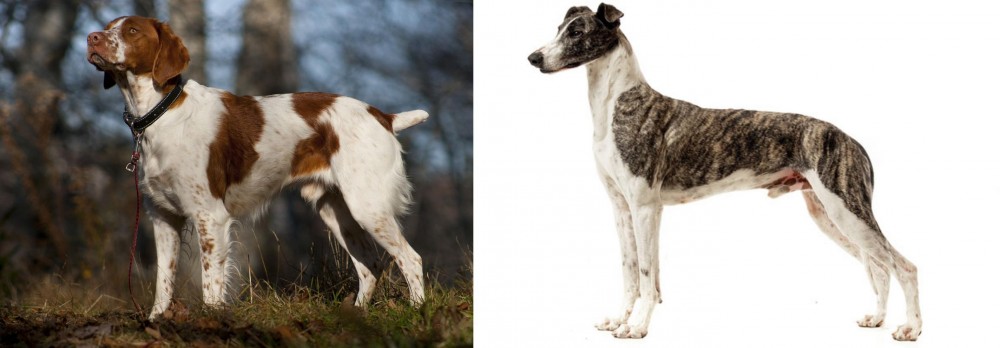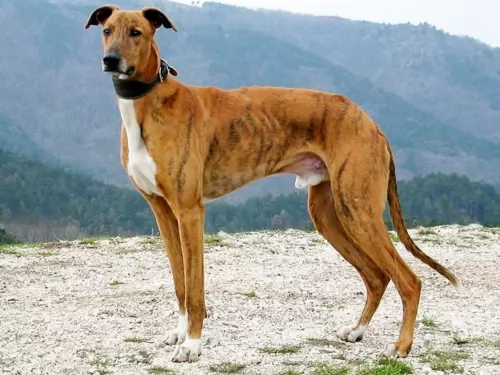 Petzlover
Petzlover Brittany is originated from France but Magyar Agar is originated from Hungary. Brittany may grow 18 cm / 7 inches shorter than Magyar Agar. Brittany may weigh 11 kg / 24 pounds lesser than Magyar Agar. Both Brittany and Magyar Agar has almost same life span. Both Brittany and Magyar Agar has almost same litter size. Both Brittany and Magyar Agar requires Low Maintenance.
Brittany is originated from France but Magyar Agar is originated from Hungary. Brittany may grow 18 cm / 7 inches shorter than Magyar Agar. Brittany may weigh 11 kg / 24 pounds lesser than Magyar Agar. Both Brittany and Magyar Agar has almost same life span. Both Brittany and Magyar Agar has almost same litter size. Both Brittany and Magyar Agar requires Low Maintenance.
 One of the most intense bird dog breeds in existence is the Brittany, bred for hunt. The breed used to be called the Brittany Spaniel, but since the breed is closer to a setter or pointer, that moniker has been dropped. The Brittany is named for the French Province in which they were originally developed. Sometime from the 17th to the 19th centuries, the breed was developed. Images of a very similar dog can be found on 17th century paintings and tapestries. However, the first written description comes from 1850 by a Reverend Davies, describing a hunting episode. The breed was recognized officially in the early part of the 20th century and made a splash at the 1900 Paris Dog Show.
One of the most intense bird dog breeds in existence is the Brittany, bred for hunt. The breed used to be called the Brittany Spaniel, but since the breed is closer to a setter or pointer, that moniker has been dropped. The Brittany is named for the French Province in which they were originally developed. Sometime from the 17th to the 19th centuries, the breed was developed. Images of a very similar dog can be found on 17th century paintings and tapestries. However, the first written description comes from 1850 by a Reverend Davies, describing a hunting episode. The breed was recognized officially in the early part of the 20th century and made a splash at the 1900 Paris Dog Show.
The first official standards were written in about 1907 and the breed was recognized by the American Kennel Club (AKC) in 1934.The Brittany is expected to point to and then retrieve birds and other small ground game. Because the Brittany both points and retrieves they are known in the U.K. as a Hunt, Point and Retrieve breed or an HPR, and they have more Dual Champions than the rest of the AKC Sporting group.
There are actually two types of Brittanys in the minds of many breeders. There is the “French” Brittany and the “American” Brittany. When the breed arrived in the United States in 1931 they became immensely popular in a short period of time. In 1942 American Breeders began the American Brittany Club, rewriting the French standard to fit the dog they knew. Today there are definitely difference between the two sub-sets that can easily be seen. The French dog is smaller than the American dog. The American dog is a runner pacing ahead of the hunter while the French dog works more closely with their human companions. Another visible difference is that the French accept black spotted Brittanys, while in the United States a black spotted coat is considered a fault. Both sub-sets are known for their willingness to follow human directions, their eagerness for the hunt, and their agility and speed.
Unfortunately, the European wars took their toll on this breed as they did on many others. Following the second World War, their numbers in Europe were drastically reduced. The French had stop breeding them altogether during the war. It was in this depleted gene pool that the French agreed to accept the black spotted Brittany. Along with the U.S., Canada also does not recognize the black spotted Brittany.
 The tall, slender Magyar Agar is a sighthound dog breed hailing from Hungary and which has been used for hunting and coursing, some dogs of which are still used for this purpose today.
The tall, slender Magyar Agar is a sighthound dog breed hailing from Hungary and which has been used for hunting and coursing, some dogs of which are still used for this purpose today.
Those who know the dog breed well will tell you that the dog isn’t the 'Hungarian greyhound', being a distinct breed with its own characteristics and breed designation.
They certainly go back centuries, and in fact, records tell us that they arrived in northeastern Hungary more than a thousand years ago.
 The Brittany is much like other hunting dogs – pointers and retrievers – in size and stature. He is solid and strong but not heavy. He is compact with an average size head and floppy ears, docked tails or short natural tails, and expressively intelligent looking eyes. He is athletic, energetic, and alert. He has a long, elastic and free gait. The French dog is smaller and the dog with black spots is accepted. The American Brittany is larger and only a tri-color of orange, liver and white is acceptable.
The Brittany is much like other hunting dogs – pointers and retrievers – in size and stature. He is solid and strong but not heavy. He is compact with an average size head and floppy ears, docked tails or short natural tails, and expressively intelligent looking eyes. He is athletic, energetic, and alert. He has a long, elastic and free gait. The French dog is smaller and the dog with black spots is accepted. The American Brittany is larger and only a tri-color of orange, liver and white is acceptable.
 Described as a large dog resembling a Greyhound and being more longer in body than being tall they are more heavily boned than the fine-boned Greyhound.
Described as a large dog resembling a Greyhound and being more longer in body than being tall they are more heavily boned than the fine-boned Greyhound.
The Magyar is a large dog standing at between 62 – 70cm in height and weighing between 22 and 31kg. If you want your Magyar to have puppies, these dogs can produce between 6 to 10. The dogs have a smooth dense coat and the coat can be any color, but not black and tan or tri-color.
The ears of the dog are short to medium and are semi-erect, semi-floppy and most times held back. The tail of the dog is long.
These are hardy dogs, and even with their short coats they are able to cope with lower temperatures. They are quiet and docile and are loving towards their human family. They also have a strong instinct to guard their owners.
They are amicable dogs, getting on well with children and pets in the home.As with most dogs, he can benefit from training and socialization. He is an adaptable dog too and will settle into life in the city or the countryside, but wherever he lives, he will need to be exercised well.
They love cozying up to their owners on the couch and thoroughly relaxing, but they also love being out and about too. A walk in the countryside or the park is a a chance to be let off the leash for some running.
 The Brittany is particularly trainable and friendly. They love to play and are sweet-natured. They don’t due well with harsh correction though and a stern look will cause them to wither. Socialize them young or they can become shy around strangers. They are loyal and family oriented. They can easily become attached to their humans.
The Brittany is particularly trainable and friendly. They love to play and are sweet-natured. They don’t due well with harsh correction though and a stern look will cause them to wither. Socialize them young or they can become shy around strangers. They are loyal and family oriented. They can easily become attached to their humans.
 The Magyar Agar may well have been developed for hunting, but today he makes a splendid pet.
The Magyar Agar may well have been developed for hunting, but today he makes a splendid pet.
He is intelligent and quiet, as well as being loyal. While he loves being outside playing or going on walks, he is quite happy to curl up on the couch with you – the nearness to you is what he loves.
Beautiful and loving, this dog symbolizes the best qualities that man wants in a canine friend.
 The breed is a hardy one and Brittanys are mostly healthy dogs. In Europe 1 in 5 dogs dies of old age and that age is usually 14 or 15 years. They do have a few issues that they may be susceptible to. These would include:
The breed is a hardy one and Brittanys are mostly healthy dogs. In Europe 1 in 5 dogs dies of old age and that age is usually 14 or 15 years. They do have a few issues that they may be susceptible to. These would include:
 The Magyar Agár is looked upon as a healthy dog breed, and with good care can live to be 12 to 14 years of age. With this dog you want to be on the lookout for some of the common dog illnesses he could succumb to -
The Magyar Agár is looked upon as a healthy dog breed, and with good care can live to be 12 to 14 years of age. With this dog you want to be on the lookout for some of the common dog illnesses he could succumb to -
This is a fairly common problem in dogs. The thyroid gland produces the hormone thyroxine with other thyroid hormones. Playing a role in the dog’s metabolism, when the thyroid is out of sync it can cause problems for your dog.
Hypothyroidism happens when your dog doesn’t secrete enough of the thyroid hormones, slowing the dog’s metabolism. Some of the symptoms include obesity, lethargy, coat thinning and cold intolerance.
This is an inherited disease of the retina, occurring in both eyes together. Thankfully it isn't painful for the dog. There are different types of inherited retinal degenerative diseases in dogs and the first signs of this are seeing your dog with night-blindness and the pupils being dilated. There is no cure, but specific antioxidant supplementation does help support the retinal health of the dog and can actually help to prevent vision loss.
Itching outbreaks from a skin allergy can make your pet miserable with constant licking and biting. Whether these allergies are inhaled, food related or from flea bites, they can cause your pet great discomfort. The fur or coat may even have started to fall out in patches. Allergies like this can occur when the dog's immune system is weakened. Feeding your dog some raw meat, getting him to the vet and providing excellent grooming can help with your pet’s skin problems.
 Don’t overfeed your Brittany. Keep him at hunting weight by feeding a half a cup up to 2 cups per day depending on the size of your dog and activity levels. Serve this in two meals not one.
Don’t overfeed your Brittany. Keep him at hunting weight by feeding a half a cup up to 2 cups per day depending on the size of your dog and activity levels. Serve this in two meals not one.
Ears – prone to infections – make sure that you check them and wipe them out routinely to prevent infections.
Hip Dysplasia – bones don’t fit well into joints – this can be genetic or otherwise, causing lameness and arthritis. If severe it can require surgery to correct.
Epilepsy – mild or serious seizures are possible. This can be genetic/hereditary but is set off by an infectious disease of the brain, head injury, poison, tumor, or metabolic disorder. There is no cure, but medication can be very effective.
Hypothyroidism – Low levels of thyroid hormone – can cause drooping eyelids, obesity, lethargy, mental difficulties or irregular heat cycles or all of this. Medication is available as it is for humans but must be taken daily for the rest of the dog’s life
Canine Discoid Lupus Erythematosus – autoimmune disease that is rare in dogs. Cats and humans can also have it. It is a skin disease and does not become the more serious and deadly Systemic Lupus. The Discoid version of this disease causes loss of pigmentation and a scaling on the nose which can then progress to the skin around the ears, eyes and genitals. There could be ulcerated lesions and tissue death in more severe cases. Sun exposure can make the condition worse.
The Brittany is a hunting dog that acts like a pointer but will retrieve fowl and birds in the water or on land. If you don’t hunt, the Brittany can still be your family dog. They need lots of exercise and mental stimulation. They need a job if they are not going to hunt and expect them to be distracted by every bird they see. Try flyball, agility, FAST CAT, field trials and dock diving. They are very task oriented and have boundless energy. They excel at obedience and confirmation as well.
 Make sure you take wonderful care of your Magyar Agar. It is a social, living creature who needs to be loved and cherished.
Make sure you take wonderful care of your Magyar Agar. It is a social, living creature who needs to be loved and cherished.
Provide him with the best food there is. If you invest in dry kibble, try and add in cooked chicken, brown rice and raw or cooked vegetables from time to time as well as some raw meat. Keep the diet simple to avoid digestive upsets.